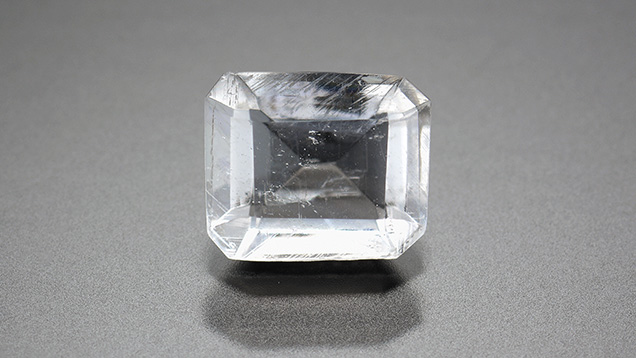Faceted Chiolite

Recently, the GIA lab in Carlsbad received a colorless 1.04 ct gemstone of a material that was new to the lab (figure 1). The measured refractive index was 1.342–1.349 with a birefringence of 0.007 and an optic character of uniaxial negative. The specific gravity, measured hydrostatically, was 3.01. These properties were consistent with the mineral chiolite, which was confirmed by Raman spectroscopy (see figure 2 and http://rruff.info/R050412).

Chiolite is a very rare transparent to translucent colorless or snow-white mineral with a vitreous luster, perfect cleavage in one direction, and a white streak. It crystallizes in the tetragonal system and is composed of sodium and aluminum, with the formula Na5Al3F14 (the presence of these elements was confirmed with EDXRF). The principal source of gem-quality material is Ivigtut, Greenland, where it occurs in association with cryolite. Other gem-quality sources include Miass in the Ilmen Mountains region of Russia, where it is found in a cryolite pegmatite, and the Morefield pegmatite mine in Virginia (see AZoMining.com). The mineral was first discovered at Miass in 1846. The name is very similar to cryolite, a related mineral. Cryolite comes from Greek for “ice stone,” while chiolite means “snow stone.” Like their namesakes, they are sometimes found together, though chiolites are rarer.
This gem has a very low hardness (3.5–4 on the Mohs scale) and perfect cleavage. The stones are usually small and nondescript. Nevertheless, chiolite has joined the ranks of minerals cut by faceters who wish to try their hand at everything clean enough to cut, and a cut stone would make quite a specimen for a gem collection.
Chiolite occurs in some granite pegmatites and is associated with ralstonite, pachnolite, elpasolite, cryolite, thomsenolite, cryolithionite, fluorite, phenakite, and topaz (see mindat.org and rruff.info).
Chiolite is difficult to cut, extremely rare, and has little commercial appeal. It is solely a curiosity in the gem world.



